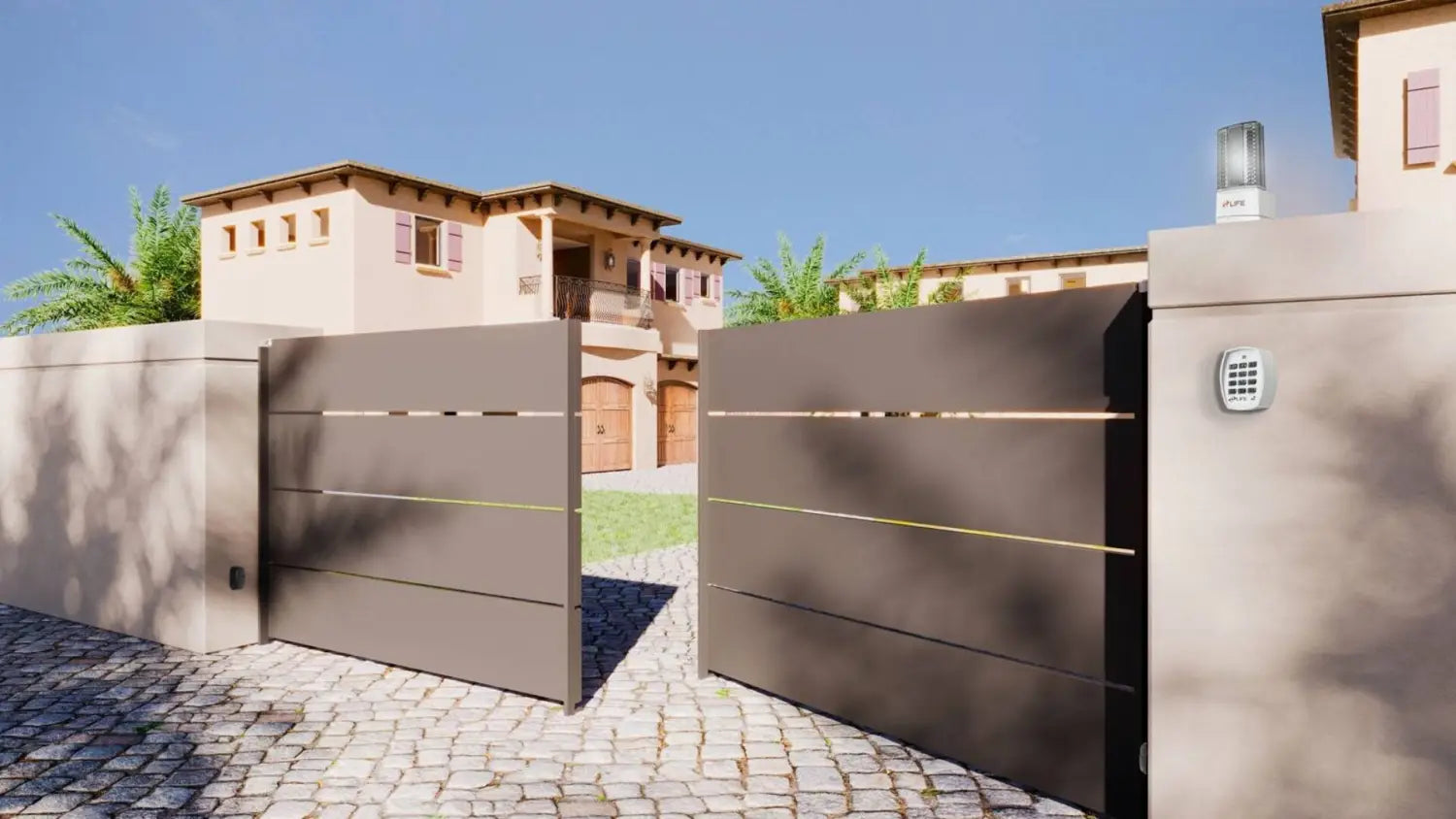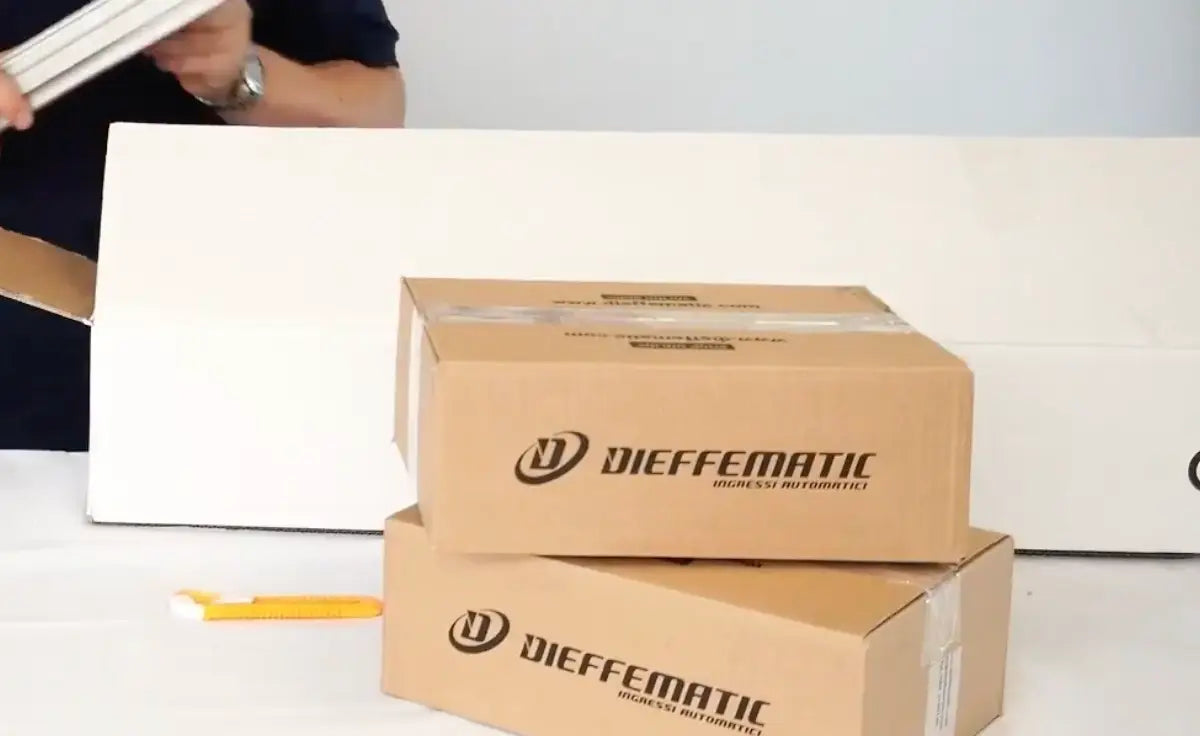Automating swing gates is an increasingly popular solution for those who want to enhance the security, convenience, and comfort of their home or business. Gate automation systems allow for the automatic control of opening and closing the gates, thus eliminating the need to get out of the car or manually operate the gate, especially in unfavorable weather conditions. These systems, which can be electromechanical or hydraulic, not only facilitate access but also significantly increase the level of security against unauthorized intrusions.

In this article, we will explore various aspects of swing gate automation: what they are, the benefits they offer, the necessary components, and how to choose the most suitable system based on your needs. Additionally, we will present the range of solutions offered by Dieffematic, including linear, articulated, and underground hydraulic and wheel motors, each designed to meet specific installation requirements.
What are swing gate automation systems?
Swing gate automation systems are electromechanical or hydraulic devices that enable the automatic opening and closing of swing gates. These systems offer a convenient and secure way to manage access to your property, eliminating the need to manually open and close the gate. Swing gates can open outwards or inwards, making them versatile and adaptable to different spatial configurations.

Why automate a swing gate?
Automating a swing gate offers numerous advantages in terms of convenience and security. With an automated system, you no longer need to get out of the car to open or close the gate, which is particularly useful in bad weather. Moreover, automation enhances property security by preventing unauthorized access and ensuring stricter control over entries and exits.
What do you need to automate a swing gate?
To automate a swing gate, several essential tools and materials are required. First, a specific automation kit for swing gates is crucial, which typically includes motors, control units, remote controls, and safety sensors. Additionally, it is important to ensure adequate power supply to run the system and the necessary wiring to connect all components. Having the right installation tools, such as drills, screwdrivers, and wrenches, will significantly ease the process.

Types of motors for swing gates
There are various types of motors for swing gates, each suitable for specific needs and configurations. Linear motors are the most common and are ideal for light to medium-sized gates, offering smooth and precise movement. Articulated motors are perfect for heavier or particularly large gates due to their increased power and durability. Underground motors offer a high aesthetic solution, as they are hidden underground and do not alter the gate's appearance. There are also hydraulic motors, which provide a robust and durable solution for large and intensive-use gates, offering excellent performance even in extreme conditions. Finally, wheel motors are ideal for uneven or sloped terrains, with the motor mounted on the wheel allowing for smoother gate movement.
The choice of motor depends on the characteristics of the gate, the frequency of use, and aesthetic preferences.
Installing the automation kit
Installing an automation kit for a swing gate involves several key steps. First, the motors must be mounted on the gate wings, ensuring they are well-aligned and securely fastened. Next, the control unit is installed in a weather-protected and easily accessible location for programming and maintenance. The electrical wires are then connected, strictly following the manufacturer's instructions to ensure correct and safe wiring. Finally, the remote controls and safety sensors are configured, ensuring to test the system to guarantee everything works smoothly.
Testing and adjustments
Initial power-up and operational testing
Before initial power-up, ensure all electrical connections and components are correctly installed. Follow these steps for the initial operational test of the swing gate:
- Powering up the system:
Ensure the power supply is connected and turn on the control unit according to the manufacturer's instructions.
- Testing gate opening and closing:
Use the remote control or control panel to open and close the gate. Check that the gate wings move smoothly and fully reach the opening and closing positions without bumps or inaccuracies.
- Adjusting the speed and opening limits:
Adjust the gate's opening and closing speed according to preferences and the manufacturer's instructions. Adjust the opening and closing limits using the integrated stops in the system. Ensure the gate wings stop correctly at the defined limits without overlapping or missing complete closure.
Troubleshooting common problems
If issues are encountered during initial testing, follow these troubleshooting tips:
- Synchronization problems:
- Ensure the two gate wings open and close in sync. If one gate wing moves faster than the other, adjust the control unit to synchronize the movements. Also, verify all remote controls are correctly paired with the gate's control system. Repeat the synchronization procedure if necessary.
- Adjusting safety sensors:
- Ensure the safety sensors are correctly installed and functioning. Check for any obstacles that might interfere with the sensors. The sensors should detect obstacles like vehicles and people and immediately stop gate movement. Adjust the sensor sensitivity according to the manufacturer's specifications.
Maintenance and support
To ensure optimal performance and longevity of the automatic swing gate, regular maintenance is crucial. It includes the following activities:
- Regular inspection of components:
Inspect all mechanical and electronic components of the gate at least once a month. Look for signs of wear, damage, or corrosion, especially on the hinges and motor arms, and replace defective parts as necessary.
- Lubrication of moving parts:
Apply lubricant to the gate's moving parts such as hinges and motor arms. Follow the manufacturer's recommendations regarding the type of lubricant and frequency of application to ensure smooth and effortless movement.
- Checking safety systems:
Regularly verify the operation of safety sensors and locking systems. Ensure the gate stops immediately if it detects an obstacle during movement.
- Motor maintenance:
Ensure the motor and control unit are clean and free of dust and debris. Check the wiring for signs of wear or damage and replace defective cables immediately. Ensure all electrical connections are secure and show no signs of burning or short-circuiting.
Following these guidelines will help maintain the automatic swing gate in optimal condition and prevent unexpected failures.
Maximize the benefits with our automatic gates!
Automating a swing gate is not just about convenience, but also about enhancing security and property value. Here is a summary of the main advantages:
- Enhanced security
- Comfort and convenience
- Increased property value
- Customization to individual needs
We are proud to offer innovative and reliable solutions for swing gate automation. If you dream of a gate that combines security, practicality, and style, explore our range of products.
Learn more about our swing gate automation products. Don't hesitate to contact us for a free consultation on your automation project. Our team of experts is ready to assist you at every stage to ensure you get exactly what you need.


